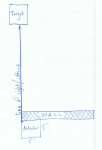Well first, total cover (as long as it's opaque) completely conceals
you. It doesn't completely conceal others
from you unless they also have total cover.
Cover is really only relevant with reference to a target, not an attacker.
Second, to explain this to you, I feel I need to use a level of abstraction with which you may not be comfortable. Think
Picasso levels of abstraction. Now, imagine that as a medium or small creature you inhabit a 5 foot by 5 foot square and that any part of you may be in any part of that square at any time. You can see from any and all points along the sides of your square you want, and if you can shoot a projectile, you can shoot it from any single point of origin along any side of the square you want. Now imagine that this square you inhabit is completely concealed behind an obstruction, but that one side of it is aligned with the edge of the obstruction. For example, if the obstruction is a length of wall, one side of your square is aligned with the very end of the wall. By placing your imaginary eye at any point on that side of the square, you can see a target on the other side of the wall, and by shooting a projectile from any point on that side of the square, you can attack a target on the other side of the wall.
edit: Here's a diagram to help visualize.
View attachment 91562


